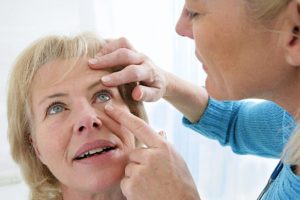As we are now hitting the hottest part of the summer, it’s a good time to talk about eye protection from the sun. You might already be aware that the ultraviolet rays from the sun can cause enough damage to your skin to cause cancer, but did you know that skin cancer is the most common form of cancer in humans? Every year in America, it affects more than 1 million people and 1 in five of us will develop skin cancer at some point in our lives.
The eyelids and eyes are not immune to the damaging UV rays of the sun…
About 15%-20% of skin lesions around the eyes and on the lids are actually some type of skin cancer, and most of these are caused in part by prolonged sun exposure. These lesions can take many shapes and sizes and are often difficult to distinguish from benign lesions unless a biopsy is performed.
What Does Eyelid Skin Cancer Look Like?
 It depends on the specific type of cancer, but there are some characteristics that make a bump more suspicious. Here’s what to look for…
It depends on the specific type of cancer, but there are some characteristics that make a bump more suspicious. Here’s what to look for…
- raised pink or pearly white bump with small, visible blood vessels
- pigmented bumps that look like moles with a pearly edge
- a sore that continuously heals and re-opens and often bleeds
- flat scaly scar with a waxy appearance and blurred edges
- crusted or scaly patch of skin with an inflamed, red base
What About “Moles” I’ve Had For Many Years?
Use the ABCDE guide for assessing whether or not a mole or other lesion may be becoming cancerous.
Asymmetry: Half the mole does not match the other half in size, shape or color.
Border: The edges of moles are irregular, scalloped, or poorly defined.
Color: The mole is not uniform in color.
Diameter: The mole is usually greater than 6 millimeters when diagnosed, but may also be smaller especially on the eyelid.
Evolving: A mole or skin lesion that is different from the rest, or changes in size, shape, or color.
If any of these conditions occur, please make an appointment to see one of Metrolina Eye’s lid lesion and cancer specialists right away. The doctor may do a biopsy of the mole to determine if it is or isn’t cancerous.
What Should I Do If I Have Eyelid Skin Cancer Or Think I Might?
The good news about eyelid skin cancers is that the vast majority of them are curable by excision alone, especially when they are identified early. They grow slowly and rarely spread. The tissues around the eye are very delicate, though, and the excision and repair of the eyelid can be tricky. Oculoplastic surgeons, like Metrolina Eye Associates’ Dr. Annunziata, are uniquely qualified and trained to both remove the lesions and repair the eyelid, even in very complicated cases, because eyelid surgery is the major focus of their training.
Because eyelid skin cancers can often be small and very difficult to identify without special equipment, you should have any new eyelid bump that does not go away looked at by a trained ophthalmologist or oculoplastic surgeon.
I’ve Spent Years In The Sun, Is It Too Late??
No!! It’s never too late to prevent further damage, even if you already have skin cancer or significant lifetime sun exposure. Roughly 90% of non-melanoma cancers are attributable to ultraviolet radiation from the sun. To reduce your risk of skin cancer:
- Stay out of the sun during peak hours (between 10 a.m. and 4 p.m.).
- Cover up the arms and legs with protective clothing.
- Wear a wide-brimmed hat and sunglasses.
- Use broad spectrum sun blocks year-round that work on both UVA and UVB rays and have SPF of 15 or greater.
- Self-check your skin monthly and contact your doctor if you notice any changes.
- Get regular professional skin examinations. It is advised that adults over 40 get an annual full body skin exam with a dermatologist and if you have skin cancer, ask your eye doctor to look at your lids and face for suspicious lesions.
To learn more about eyelid skin cancer, call Metrolina Eye Associates today to schedule an appointment with one of our eyelid specialists. In the mean time, have a happy, relaxing and safe summer!



